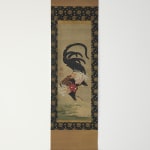Itō Jakuchū (1716−1800)
Rooster
Color on silk, hanging scroll
Double boxed
Seals: To Jokin in, Jakuchu koji
92.7 x 32.7 cm
179.5 x 45.5 cm (overall)
Further images
Standing on the right leg looking at the left and curling the left leg up, such a posture of rooster is commonly seen in Jakuchu’s works. A famous example is his early work Hydrangeas, Rooster, and Hen in the Price Collection, Los Angeles County Museum of Art, which is extremely similar to the one on the same subject in the Colorful Realm of Living Beings series in the Sannomaru Shozo-kan, the Museum of Imperial Collections, which bears a date of Horeki 9 (1759). Another example is found on the fusuma-e painting, or the sliding panel painting, dated Kansei 2 (1790), in Saifuku-ji Temple in Osaka. The posture of the rooster there resembles to the above-mentioned works, albeit it standing on the left, rather than right leg. The present work is supposedly made between the Colorful Realm of Living Beings series and the fusuma-e painting; more precisely speaking, its overall style is closer to the former. That the rooster lifts its left leg up to the face in the present work is seen in none of the said three. The same posture can be found in Rooster in the Snow in the Okada Museum of Art, yet the pattern and the depiction of the feathers are slightly different. Moreover, compared with the snowy scene in the background of the Okada painting, the composition of the present work appears relatively simple yet never feels dull. The algae-like and the thorn-like grasses on the ground, unlike those in the Colorful Realm of Living Beings series, are painted lightly in contrast to the heavily colored rooster. The ground gradually dimmed towards the lower center of the work with the right side lighter up, leading the viewer’s eyes towards the rooster’s gaze.
Ito Jakuchu (painter; 1716−1800)
Also known as Jokin; Keiwa; Tobeian; Beito’o.
Kyoto-born mid to late Edo period painter. Established his unique style upon studying from the Kano school paintings, Song, Yuan, and Ming dynasties paintings, and Ogata Korin’s works. His rooster paintings are well-recognized as known as “Jakuchu’s rooster.”
Ito Jakuchu (painter; 1716−1800)
Also known as Jokin; Keiwa; Tobeian; Beito’o.
Kyoto-born mid to late Edo period painter. Established his unique style upon studying from the Kano school paintings, Song, Yuan, and Ming dynasties paintings, and Ogata Korin’s works. His rooster paintings are well-recognized as known as “Jakuchu’s rooster.”





